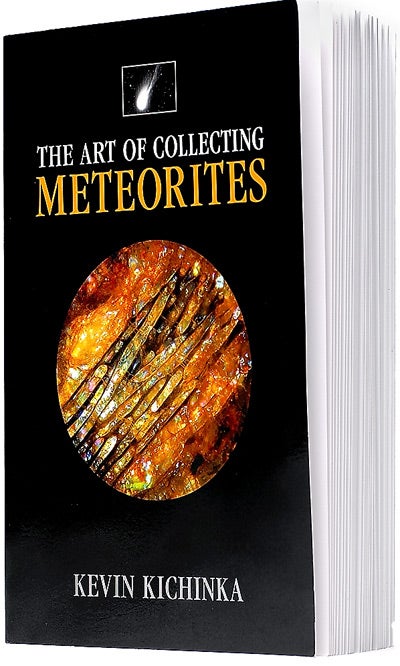Kevin Kichinka, 232 pages, Bookmasters, 2005; paperback, $21.95
Kevin Kichinka’s new book, The Art of Collecting Meteorites, is an appealing mixture of information about meteorites. He touches on topics ranging from identifying, acquiring (both in the field and purchasing), and curating meteorites, to a brief-but-thorough history of meteoritics.
Kichinka ties in essays by others in the field, relying on their firsthand knowledge and experience. This strengthens the book and adds to its readability. A section that includes personal collecting stories is one of my favorites. Whether written by H. H. Nininger — the father of modern meteorite recovery — or dealer and collector Robert Haag — best known as the Meteorite Man — the stories are a wonderful part of the book.
I especially enjoyed the story of Kichinka and Blaine Reed’s (a well-known meteorite dealer) attempts to find a meteorite in Bolivia. No known meteorite had been recovered in Bolivia before, and the weaving of this tale, as well as Reed’s historic find, is fascinating.
The vast majority of the material presented in The Art of Collecting Meteorites is good advice for everyone. However a couple of glaring errors, more astronomical in nature than specific to meteoritics and meteorite collecting, exist. In particular, Kichinka notes, “Everyone knows that Galileo invented the telescope.” After this statement, he goes on to review the history of Thomas Harriot and his lunar observations, prior to Galileo’s own work. The problem is that Galileo did not invent the telescope. That honor is usually bestowed on Dutchman Jan Lippershey, even though there are those who believe Lippershey wasn’t the first to combine lenses for astronomical observations.
| Digital Astrophotography: The State of the Art |
| Edited by David Ratledge, 184 pages, Springer-Verlag Limited, 2005; paperback, $34.95 |
 This David Ratledge book gives a nice introduction to the field of digital astrophotography. Ratledge covers many subsets of the hobby: stacking images and using webcams, computer processing, and taking high-resolution images of planets. He also discusses more advanced techniques such as hybrid imaging and amateur spectroscopy. However, whenever an author covers so many topics in 180 pages, he/she can provide only an overview. This book is a good place to start and learn about the basics in the field. Then you can decide which topics you’d like to research more in depth. This David Ratledge book gives a nice introduction to the field of digital astrophotography. Ratledge covers many subsets of the hobby: stacking images and using webcams, computer processing, and taking high-resolution images of planets. He also discusses more advanced techniques such as hybrid imaging and amateur spectroscopy. However, whenever an author covers so many topics in 180 pages, he/she can provide only an overview. This book is a good place to start and learn about the basics in the field. Then you can decide which topics you’d like to research more in depth. — Liz Kruesi |
Kichinka’s point, however, is that credit is often not given to the correct person in history, in this case an Englishman named William Thomson. In 1804, Thomson noted a series of lines or patterns on certain iron meteorites when sliced and then chemically treated. These patterns are today referred to as the Widmanstätten pattern. Alois von Widmanstätten repeated the experiment some 4 years after Thomson (and 2 years after Thomson’s death) and was credited for the discovery. Kichinka nicely documents this historical detail, even with the Galileo error.
With this type of book, I would like to see a more-detailed reference section. Kichinka lists some materials and references, but for the avid collector — and even the beginner — a detailed up-to-date reference list is helpful.
So, who should read Kichinka’s The Art of Collecting Meteorites? Anyone interested in meteoritics will enjoy this book, and it’s a must for meteorite collectors’ bookshelves. If you have a passing interest in meteorites or astronomical history, you would also enjoy the book. — Mike D. Reynolds is a college astronomy professor, has researched and collected meteorites for over 42 years, and is still the proud owner of his first meteorite — a Canyon Diablo meteorite he purchased in 1963.










